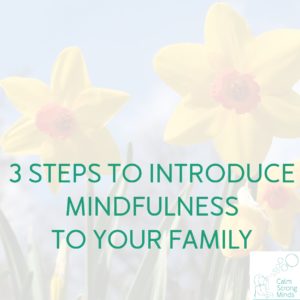Getting Started
As I’m writing this first blog post, I am reminded how hard it can be to start something new. Even if mindfulness meditation is something that we want to do or even feel we need to do, it can be hard to actually take that step to bring it into our lives.

Often we are so busy with the standard daily grind, it can feel overwhelming to try and introduce something extra to the already hectic days. We know the principle that looking after ourselves is important and try to instil this in our children, but it can still feel selfish to take time for ourselves.
But what if we replace the word ‘selfish’ with ‘self-care’?
Practising mindfulness, bringing awareness and focus to our daily lives, doesn’t have to be complex or time-consuming. Indeed when introducing it to children and young people it is often the simple mindful activities that can be the most enjoyable and effective. These activities can also, over time, help us to feel more grounded, in control, less stressed, and more connected. As with any behaviour change, once you become familiar with living mindfully, finding time for dedicated mindfulness practice will start to feel a natural part of daily life.
Step 1: Setting Intention
There is no such thing as goal setting in mindfulness, however it can be incredibly helpful to set an intention. An intention is about creating purpose, a focus to your reasoning and attention. Spend some time thinking about: why are you doing the practice? who are you doing it for? what do you want to gain from including mindfulness practice in your life?
By answering these questions, it will be easier to focus your attention to the meditation practice and help to remind you that this is about self-care, not about being selfish.
Step 2: Creating Space
You do not need anything special to bring mindfulness into your life. However, it is important to create space in your day and in your mind to complete even a brief mindfulness meditation. It can help to spend time thinking about how you will create the space to maintain your mindfulness practice over time. Perhaps it is about setting aside 10 minutes a day at the same time everyday, including a meditation into the children’s bedtime routine, or even simply turning your phone onto aeroplane mode so you are not disturbed during your practice. You might even want to share your intention to bring mindfulness into your life with another person who can support you, perhaps even join you in your journey.

Step 3: Beginning
So, you’ve thought about your intentions and motivations, you’ve created a space in your day, now what?! A good place to start is a basic body scan:
Start by sitting cross legged on the floor, on a chair with your back supported and feet on the ground, or lying down – whichever is most comfortable for you.
Take 3 deep breaths and bring your attention to the rise and fall of the breath in your lungs.
Bring your attention to your body as you scan down and notice the sensations or feelings in your body at that place. Is it heavy or light, free or uncomfortable, relaxed or tense?
Start at the top of your head, slowly bring your attention down your body. Starting with the scalp, eyes, nose, mouth, ears, tongue, chin.
Then down to your neck, shoulders, arms and hands.
Your chest, stomach, back.
Legs, feet and toes.
This exercise is so versatile and adaptable for any age. For younger children perhaps use a feather to guide their thoughts through the different body parts, for older children imagine there is a torch light or sun beam scanning their body, and for teens using the script but possibly over a shorter timespan.
There are lots of guided body scans online too. Do let me know which ones are your favourites.
So, with these 3 steps in mind, why don’t you make it your intention to prioritise self-care a little bit more today? As I press ‘publish’ on this blog post, why don’t you let me know what step you have taken in line with your intention for today?